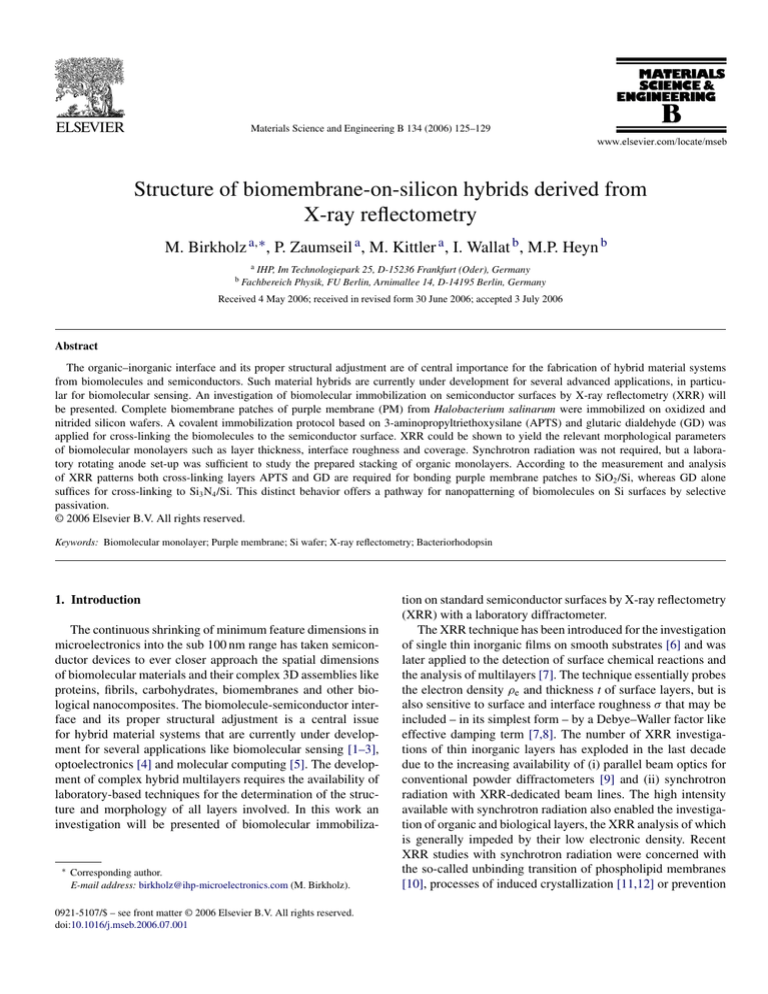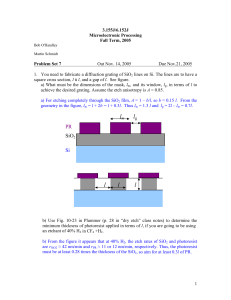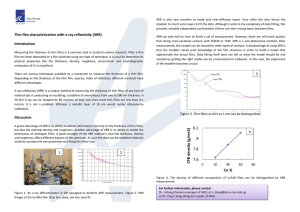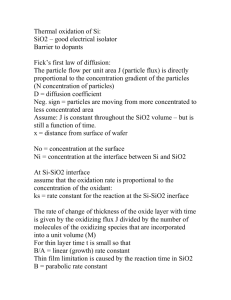
Materials Science and Engineering B 134 (2006) 125–129
Structure of biomembrane-on-silicon hybrids derived from
X-ray reflectometry
M. Birkholz a,∗ , P. Zaumseil a , M. Kittler a , I. Wallat b , M.P. Heyn b
a
b
IHP, Im Technologiepark 25, D-15236 Frankfurt (Oder), Germany
Fachbereich Physik, FU Berlin, Arnimallee 14, D-14195 Berlin, Germany
Received 4 May 2006; received in revised form 30 June 2006; accepted 3 July 2006
Abstract
The organic–inorganic interface and its proper structural adjustment are of central importance for the fabrication of hybrid material systems
from biomolecules and semiconductors. Such material hybrids are currently under development for several advanced applications, in particular for biomolecular sensing. An investigation of biomolecular immobilization on semiconductor surfaces by X-ray reflectometry (XRR) will
be presented. Complete biomembrane patches of purple membrane (PM) from Halobacterium salinarum were immobilized on oxidized and
nitrided silicon wafers. A covalent immobilization protocol based on 3-aminopropyltriethoxysilane (APTS) and glutaric dialdehyde (GD) was
applied for cross-linking the biomolecules to the semiconductor surface. XRR could be shown to yield the relevant morphological parameters
of biomolecular monolayers such as layer thickness, interface roughness and coverage. Synchrotron radiation was not required, but a laboratory rotating anode set-up was sufficient to study the prepared stacking of organic monolayers. According to the measurement and analysis
of XRR patterns both cross-linking layers APTS and GD are required for bonding purple membrane patches to SiO2 /Si, whereas GD alone
suffices for cross-linking to Si3 N4 /Si. This distinct behavior offers a pathway for nanopatterning of biomolecules on Si surfaces by selective
passivation.
© 2006 Elsevier B.V. All rights reserved.
Keywords: Biomolecular monolayer; Purple membrane; Si wafer; X-ray reflectometry; Bacteriorhodopsin
1. Introduction
The continuous shrinking of minimum feature dimensions in
microelectronics into the sub 100 nm range has taken semiconductor devices to ever closer approach the spatial dimensions
of biomolecular materials and their complex 3D assemblies like
proteins, fibrils, carbohydrates, biomembranes and other biological nanocomposites. The biomolecule-semiconductor interface and its proper structural adjustment is a central issue
for hybrid material systems that are currently under development for several applications like biomolecular sensing [1–3],
optoelectronics [4] and molecular computing [5]. The development of complex hybrid multilayers requires the availability of
laboratory-based techniques for the determination of the structure and morphology of all layers involved. In this work an
investigation will be presented of biomolecular immobiliza-
∗
Corresponding author.
E-mail address: birkholz@ihp-microelectronics.com (M. Birkholz).
0921-5107/$ – see front matter © 2006 Elsevier B.V. All rights reserved.
doi:10.1016/j.mseb.2006.07.001
tion on standard semiconductor surfaces by X-ray reflectometry
(XRR) with a laboratory diffractometer.
The XRR technique has been introduced for the investigation
of single thin inorganic films on smooth substrates [6] and was
later applied to the detection of surface chemical reactions and
the analysis of multilayers [7]. The technique essentially probes
the electron density ρe and thickness t of surface layers, but is
also sensitive to surface and interface roughness σ that may be
included – in its simplest form – by a Debye–Waller factor like
effective damping term [7,8]. The number of XRR investigations of thin inorganic layers has exploded in the last decade
due to the increasing availability of (i) parallel beam optics for
conventional powder diffractometers [9] and (ii) synchrotron
radiation with XRR-dedicated beam lines. The high intensity
available with synchrotron radiation also enabled the investigation of organic and biological layers, the XRR analysis of which
is generally impeded by their low electronic density. Recent
XRR studies with synchrotron radiation were concerned with
the so-called unbinding transition of phospholipid membranes
[10], processes of induced crystallization [11,12] or prevention
126
M. Birkholz et al. / Materials Science and Engineering B 134 (2006) 125–129
Table 1
Assumed XRR simulation parameters for the materials considered in this work; critical angles θ c are specified for usage of Cu K␣ radiation
Material
Stoichiometry
Mass density (g cm−3 )
Electron density, ρe (nm−3 )
Critical angle, θ c (◦ )
Silicon
Silicon dioxide
Silicon nitride
3-Aminopropyltriethoxysilane
Glutaric dialdehyde
Purple membrane
Si
SiO2
Si3 N4
C9 H23 NO3 Si
C5 H8 O2
∼C74 H140 N14 O21 PNa
2.33
2.20
3.20
0.949
1.06
1.35
699
662
961
315
345
441
0.223
0.217
0.261
0.149
0.149
0.176
of protein unfolding by cross-linking at the gas–water interface
[13], polymer surface gratings [14], the structural order of
organic-on-inorganic semiconductors [15] and the increase of
organic layer stability by capping with aluminum oxide [16]
to mention only a few examples. Further details of the XRR
technique are outlined, for instance, in Refs. [17] or [9].
In this work, layers of SiO2 and Si3 N4 on Si wafers were
selected as the relevant substrate materials, since both surfaces
represent fundamental terminations in CMOS (complementary
metal-oxide semiconductor) technology. A widely used immobilization procedure was applied that makes use of a cross-linking
protocol based on 3-aminopropyltriethoxysilane (APTS) and
glutaric dialdehyde (GD) [2,18,19]. The working principle of
this two-step cross-linking procedure is to convert the initial
Si–OH terminated surface to amino groups—NH2 and subsequently aldehyde groups—CHO, the latter of which bind to the
protein. Complete patches of so-called purple membrane (PM)
from Halobacterium salinarum comprising the bacterial protonpump bacteriorhodopsin as integral membrane protein, were
selected as biomolecules to be immobilized on oxide covered
and nitride covered Si wafers. Purple membrane patches have a
thickness of about 5.6 nm and an average lateral dimension of
some 100 nm.
2. Experimental
B-doped CZ-Si wafers of (0 0 1) orientation, 200 mm diameter and 575 m thickness with 20–60 cm were used as substrates. Cover layers of SiO2 and Si3 N4 with an intentional
thickness of 5 nm were prepared by thermal oxidation at 800 ◦ C
and chemical vapor deposition at 690 ◦ C, respectively. Pieces
of 40 mm × 40 mm were cut from the wafers after discharging from the IHP clean room. Immobilization experiments were
performed by consecutively exposing the oxide or nitride covered Si plates to solutions of APTS, GD and purple membrane
patches (PM). APTS and GD were purchased from Sigma and
diluted to 6.6 vol.% in Cl3 CH and 0.4 mM in H2 O, respectively.
Ultrapure water from Millipore was used for all washing and
dilution procedures (MilliQ PF-plus, >18.2 M). Purple membrane patches were harvested from the ET1001 strain (wild type,
formerly S9) and diluted to contain 0.75 M bacteriorhodopsin.
Reaction times were set to 2, 10 and 60 min for solutions of
APTS, GD and PM, respectively, while the samples were rinsed
in water, or Cl3 CH in case of APTS, after each reaction. After
the preparation was finished the hybrid samples were kept in
a high-humidity atmosphere in order to avoid dehydration of
purple membrane patches, which are known to structurally deteriorate at low humidity. The XRR properties of materials used
are given in Table 1.
Measurements of X-ray reflectivity were performed with
a rotating anode diffractometer set-up (Rigaku RU 300) and
applying Cu K␣ radiation. The generator was operated under
20 kV/10 mA or 50 kV/150 mA during the measurement according to whether the scattering angle range was scanned up to 2◦
or between 1.5◦ and 10◦ . This procedure avoided damage to
the detector due to the high reflectivity in the vicinity of the
critical angle. The scattered X-ray beam was monochromatized
before entering the detector by a graphite monochromator of
(0 0 0 2) orientation. Albeit the diffractometer operates in the
widely used para-focussing mode, a quasi-parallel beam setting
was achieved by choosing the smallest divergence slit available of only 0.05◦ . This in-scattering-plane divergence translates
into a beam height of 0.16 mm at the sample center position
(Rdiff = 185 mm). During the XRR measurement the sample was
exposed to a saturated humidity atmosphere that was contained
in the sample housing by closing the windows with an X-ray
transparent plastic foil (4 m Trespaphan). Reflectivity scans
between 0.1◦ and 10◦ were collected with a step size of 0.01◦
and an integration time of 2 s for low and medium scattering angle range. The analysis of XRR pattern was performed
by virtue of the reflectivity simulation and regression program
RCRefSim [20].
3. Results and discussion
Fig. 1 shows the measured XRR patterns of the SiO2 /Si
sample (bottom) and the same sample subjected to the immobilization protocol (top), i.e. having purple membrane patches
intentionally attached to the SiO2 surface via cross-linking with
APTS and GD. Dots represent measured data points, while solid
lines indicate simulations according to layer architecture models
as outlined below.
The pattern from the oxide covered wafer, Fig. 1 (bottom)
is realized to span an intensity range of about seven orders of
magnitude. Although a thickness of the oxide of only 5 nm was
intended a reliable fit to the data could only be obtained by modeling the SiO2 layer with a thickness of 5.5 nm and an effective
(root-mean-square, rms) roughness of 0.34 nm. The relative density exceeded the theoretical value of 2.33 g/cm3 by 6%. Errors
are given for the last digits by numbers in parentheses. The reliability value S1 of the numerical regression decreased further
by introducing a surface layer of low electron density and only
M. Birkholz et al. / Materials Science and Engineering B 134 (2006) 125–129
Fig. 1. Measured (gray dots) and simulated XRR pattern (black lines) of SiO2 /Si
(bottom) and PM/GD/APTS/SiO2 /Si (top).
0.5 nm thickness on top of the SiO2 , which could either indicate
a water layer or a silicon-hydroxide surface monolayer upon the
oxide film. A rather small S1 value of 2.6% was finally achieved.
The XRR pattern of the oxide sample with intentionally
immobilized PM patches, given in Fig. 1 (top), exhibits a distinctively different course of intensity than the pure oxide sample
although no well-pronounced Kiessig fringes are observed. The
analysis of the pattern was performed by subjecting all possible
layer architectures that might have been formed to a numerical
regression. If SiO2 , APTS, GD and PM are further abbreviated
by characters O, A, G and P, the seven layer systems O, AO,
GAO, PGAO, PGO, PAO and PO might have been prepared
in principle. Here, the top layer is given as the first character.
For instance, GAO stands for the GD/APTS/SiO2 /Si multilayer
model, while O would account for an uncovered SiO2 /Si sample with completely absent APTS, GD and PM layers. For all
seven-layer models reliable starting parameters were inserted
into the simulation program in order to identify a small-S1 fit
to the measured data. The electron densities given in Table 1
were used for this purpose. Fit models were rejected for implausible fit parameters, which were assumed of having arrived at
when either the electron density surmounted the values given in
the table by more than 50%, when the roughness of a layer σ
increased over its thickness t or when the final S1 value exceeded
20%.
On the basis of these criteria the intended layer architecture
of PGAO turned out as the one with the smallest S1 value of
5.1% and the most reliable fit parameters. Alternative models
like AO, GAO and GO yielded S1 values of 8.7%, 7.9% and
17.3% in combination with implausible parameter values. It can
be concluded that the regression of the measured data yielded
in fact the intended layer stacking of purple membrane patches
127
bonded to the SiO2 /Si substrate via cross-linking molecules GD
and APTS. The parameters of the best-fit model architecture are
given in Table 2 and partially in Fig. 1, where the solid line is
calculated on the basis of this model. The relative density in the
table accounts for the fitted electron density ρe in fractions of
the theoretical density specified in Table 1.
The numerical results presented in Table 2 shall now be discussed. Firstly, the oxide layer parameters were fixed to the
values obtained from the fitting of the SiO2 /Si sample without the water layer on top. Secondly, the relative density of the
APTS layer exceeds by 20% the value it attains in solution. This
might be a reliable result, since APTS molecules are generally
considered to vertically bond to the SiO2 surface and, moreover, to horizontally cross-link to molecular neighbors, which
will be associated with a density increase of a surface-bonded
monolayer of APTS. Thirdly, the thickness of the GD layer is
realized to exceed the lengths of the GD molecule of about 1 nm.
This might be understood from the ability of GD to form some
multilayer thick polymers upon APTS due to the symmetric
functional –CHO groups of the molecule [2]. A further point of
interest relates to the relative density of the PM layer that translates into coverage of about 23%. A less than complete coverage
has been observed in various other investigations that made use
of the APTS-GD cross-linking scheme [1,18]. Finally, the value
for the PM layer thickness of 5.6 nm is in good agreement with
literature values. It can thus be concluded that the thickness and
relative density values of the model architecture yielded reliable
results that are in accordance with previous investigations by
other techniques than XRR.
Reflectometry patterns of the nitrided wafer prior to and
after immobilization are shown in the bottom and top of Fig. 2.
Both measurements yielded clearly visible Kiessig fringes that
are mainly caused by the 6.4 nm thin nitride layer the electron
density of which differs by about 50% from the underlying Si
wafer, see Table 1. This is in strong contrast to the SiO2 /Si system, where the electron density difference between surface layer
and substrate is only in the 5% range. Subjecting the Si3 N4 /Si
wafer to the APTS-GD-PM immobilization procedure yielded
an XRR pattern that appears comparable to the wafer prior to
immobilization, compare Fig. 2. Various numerical simulations,
however, reveal that purple membrane patches have covalently
been bonded to the surface via an intermediate glutaric dialdehyde layer. The architecture of the best-fit PGN model is shown
as inset in Fig. 2. As for the oxide system various model systems like N, AN, GN, GAN, PN, PGN, PAN and PGAN were
tested to fit the measured data, where N stands for the nitride
Table 2
Layer architecture parameters of the best-fit model for PM immobilization on
SiO2 /Si
No.
Layer
Thickness (nm)
Roughness (nm)
Relative density
1
2
3
4
5
PM
GD
APTS
SiO2
Si substrate
5.6
1.1
1.2
5.2
∞
0.8
0.6
0.1
0.3
0.2
0.23
1.06
1.21
1.07
1.00
128
M. Birkholz et al. / Materials Science and Engineering B 134 (2006) 125–129
with glutaric dialdehyde only. This result may also apply to other
biomolecules than complete PM patches and may offer a strategy for the surface patterning of semiconductor surfaces with
biomolecules.
4. Conclusions
Fig. 2. Measured (gray dots) and simulated XRR pattern (black lines) of
Si3 N4 /Si (bottom) and PM/GD/Si3 N4 /Si (top).
Si3 N4 layer and the other symbols have the same meaning as
explained above. In case of a silicon dioxide coating the application of the procedure would have led to a PM/GD/APTS layer
architecture, but the usage of a nitride coated wafer results in a
PM/GD stack directly bound to the Si3 N4 layer. Different models like PGAN or GN yielded significantly larger S1 values. The
numerical values of the final fit PGN model are given in Table 3.
This result may be explained by assuming that APTS does
not bond to the Si3 N4 surface. On the other hand, the connection between PM patches and the nitride can be achieved
through cross-linking with GD. Accordingly, the immersion step
of nitrided wafers in APTS may be omitted, since the immobilization may already be achieved by cross-linking with GD
alone. This is naturally understood from the nitrogen termination of the Si3 N4 surface to which glutaric dialdehyde may
covalently bond. The same bonding scheme is made use of by
converting the SiO2 surface with APTS to a nitrogen-terminated
surface. This reduced cross-linking scheme for nitrided surfaces
was verified by succeeding experiments, where PM was immobilized after cross-linking with GD only. And, in fact, the XRR
pattern obtained yielded the smallest S1 values when modeled by
PM/GD/Si3 N4 /Si. It is concluded that purple membrane patches
may be immobilized on nitrided silicon surfaces by cross-linking
Table 3
Layer architecture parameters of the best-fit model for PM immobilization on
Si3 N4 /Si
No.
Layer
Thickness (nm)
Roughness (nm)
Relative density
1
2
3
4
PM
GD
Si3 N4
Si substrate
5.7
2.6
6.2
∞
0.7
0.7
0.5
0.1
0.25
1.14
0.90
1.00
The immobilization of complete purple membrane patches on
SiO2 and Si3 N4 terminated Si wafer surfaces have successfully
been demonstrated by a covalent cross-linking scheme. X-ray
reflectometry was found to be capable of probing even monolayers of biomolecules, albeit only a laboratory set-up was used
instead of synchrotron radiation that is more commonly applied
for thin films containing low-Z elements. The determination of
biolayers became possible through the usage of a high-intensity
rotating anode and the quasi-parallel beam configuration, i.e. the
usage of a very small divergence slit. Important structural and
morphological parameters of biomolecular immobilization like
layer thickness and interface roughness may then be obtained.
Moreover, the obtained relative density may be interpreted as
surface coverage and XRR thus allows for the quantitative determination of efficiency of immobilization procedures. It can thus
be concluded that a complicated layer architecture has successfully been elucidated here. It has to be emphasized, however, that
a reliable analysis and interpretation of XRR patterns from complex multilayer systems always has to be performed on a firm
modeling basis, i.e. the structure determination is always a decision between distinct alternative structure models rather than
the structure is determined in an ab initio approach. Comparing
XRR and optical ellipsometry, the first method directly yields
the layer thickness; whereas only the effective layer thickness
– which is the product of the refractive index and layer thickness – is achieved by the second technique. The advantage of
XRR for thin film analysis is caused by the small deviation of
the refractive index from unity. The investigation has shown that
biomembrane patches may covalently be bound to SiO2 /Si by
cross-linking with APTS and GD and to Si3 N4 /Si by using GD
alone. This distinct immobilization behavior should allow for
the patterning of biomolecules on semiconductor surfaces by
selective passivation.
Acknowledgements
The authors like to thank the staff from the IHP pilot line
for processing of the silicon wafers. This work has partially
been supported by the Volkswagen-Stiftung through the SOBSI
project (self-organized pattern formation of biomolecules at silicon surfaces, see www.mpi-halle.mpg.de/∼sobsi/home.htm).
References
[1] M. Thust, M.J. Schöning, J. Vetter, P. Kordos, H. Lüth, Anal. Chim. Acta
323 (1996) 115.
[2] A.K. Singh, A.W. Flounders, J.V. Volponi, C.S. Ashley, K. Wally, J.S.
Schoeniger, Biosens. Bioelectr. 14 (1999) 703.
[3] R. Hölzel, F.F. Bier, AIP Conf. Proc. 725 (2004) 77.
[4] P. Bhattacharya, J. Xu, G. Váró, D.L. Marcy, R.R. Birge, Opt. Lett. 27
(2002) 839.
M. Birkholz et al. / Materials Science and Engineering B 134 (2006) 125–129
[5] C.P. Collier, E.W. Wong, M. Belohradský, F.M. Raymo, J.F. Stoddart, P.J.
Kuekes, R.S. Williams, J.R. Heath, Science 285 (1999) 391.
[6] H. Kiessig, Ann. Phys. 10 (1931) 769.
[7] L.G. Parratt, Phys. Rev. 95 (1954) 359.
[8] S.K. Sinha, E.B. Sirota, S. Garoff, H.B. Stanley, Phys. Rev. B 38 (1988)
2297.
[9] M. Birkholz, Thin Film Analysis by X-ray Scattering, Wiley-VCH, Weinheim, 2006 (Chapter 4).
[10] M. Vogel, C. Münster, W. Fenzl, T. Salditt, Phys. Rev. Lett. 84 (2000) 390.
[11] K. Larson, D. Vaknin, O. Villavicencio, D. McGrath, N. Stephenson, V.V.
Tsukruk, Polym. Mater.: Sci. Eng. 85 (2001) 229.
[12] D. Vaknin, S. Dahlke, A. Travesset, G. Nizri, S. Magdassi, Phys. Rev. Lett.
93 (2004) 218302.
[13] D. Gidalevitz, H. Zhengqing, S.A. Rice, Proc. Natl. Acad. Sci. 96 (1999)
2608.
129
[14] T. Geue, M. Schultz, J. Genzer, U. Pietsch, A. Natansohn, P. Rochon, J.
Appl. Phys. 87 (2000) 7712.
[15] A.C. Dürr, F. Schreiber, M. Münch, N. Karl, B. Krause, V. Kruppa, H.
Dosch, Appl. Phys. Lett. 81 (2002) 2276.
[16] S. Sellner, A. Gerlach, F. Schreiber, et al., Adv. Mater. 16 (2004)
1750.
[17] P. Fewster, X-ray Scattering from Semiconductors, Imperial College Press,
London, 2003.
[18] B. Schnyder, R. Kötz, D. Alliata, P. Facci, Surf. Interface Anal. 34 (2002)
40.
[19] T. Schiestel, H. Brunner, G.E.M. Tovar, J. Nanosci. Nanotech. 4 (2004)
504.
[20] P. Zaumseil, RCRefSim (rocking curve and reflectivity simulation), program available from the author (zaumseil@ihp-microelectronics.com)
Frankfurt (Oder), 2005.




